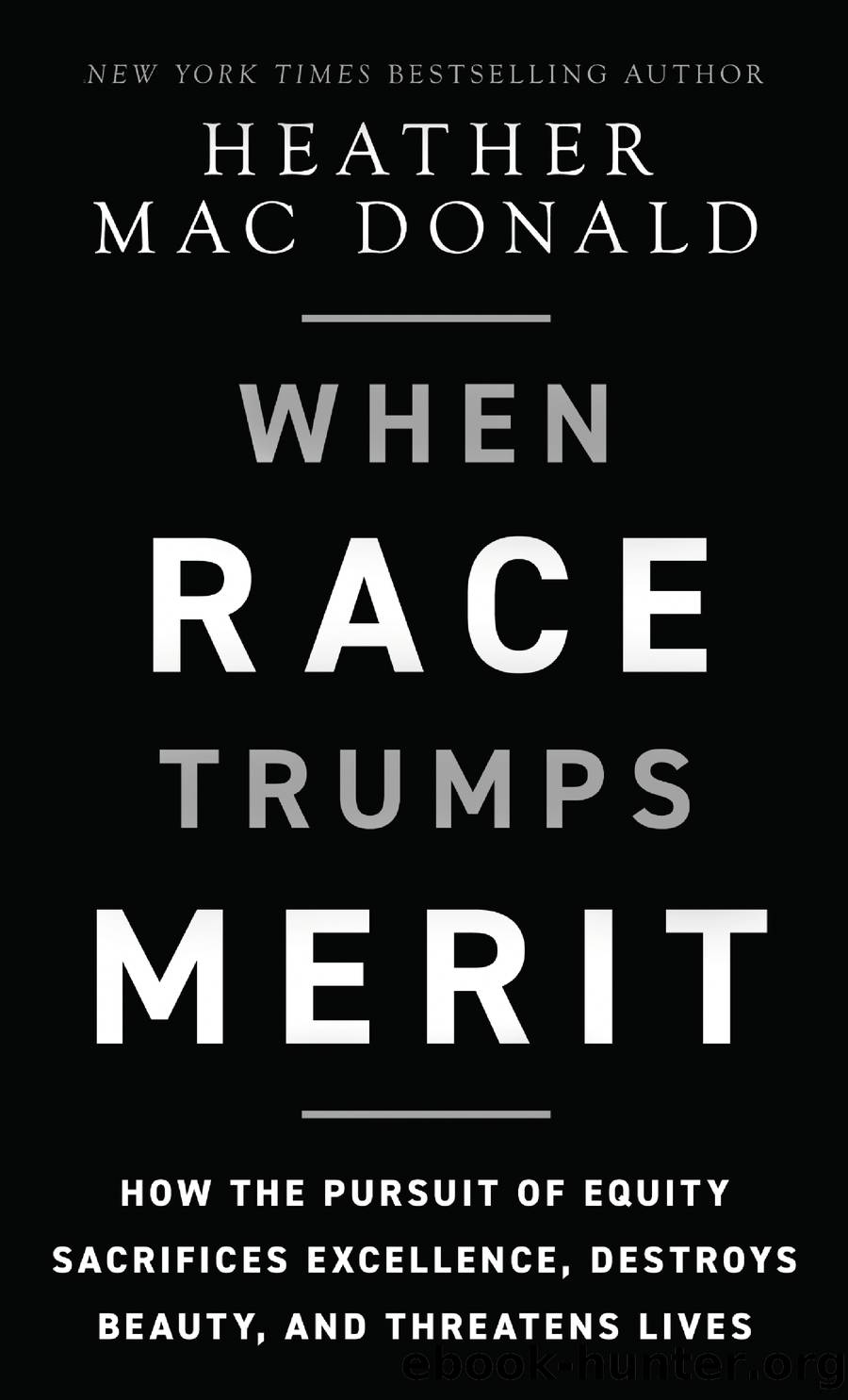When Race Trumps Merit by Heather Mac Donald

Author:Heather Mac Donald [Mac Donald, Heather]
Language: eng
Format: epub
ISBN: 9781956007268
Publisher: DW Books
Published: 2023-02-25T17:33:50+00:00
A final link in the chain of creation must be broken if the Metâs war on the European tradition is to succeed: the art market. If a white artist tries to sell his art, he is engaged yet again in white supremacy, according to the Met. At the time of Why Born Enslaved!, Carpeaux had barely escaped bankruptcy, having invested huge sums of his own money into creating a sculpture for the Paris Opera House. Economic difficulties hounded Carpeaux throughout his life; he sometimes had to auction off his works at bargain basement prices. Carpeaux created Why Born Enslaved! with the hope of saleâjust as nearly every other post-Gothic artist has done. But according to Nelson, that commercial end undercuts any abolitionist meaning that a naïve viewer may attribute to the bust. Since the work âwas designed to meet consumer desire,â Nelson writes, it should be seen as a vehicle for âcolonialist fantasies about the physical possession and containment of Black womenâs bodies.â22
The art press ran with the Metâs anti-commercial theme. New York Times art critic Holland Cotter dismissed any abolitionist motivation for Josiah Wedgewoodâs anti-slavery medallion, since it, too, entered the stream of commerce. Once the medallion was offered for sale, it became merely a âcommodified emblem of Black abjection and white paternalism,â Cotter writes in his review of the Fictions show.23
These coddled curators and critics are detached from reality. Absent ecclesiastical or aristocratic patronage, an artistâs only mechanism for survival is the market. Perhaps these snobs imagine that artists should rely on Ford, Rockefeller, and Andrew Mellon foundation support (though good luck to any heterosexual white male artist seeking such philanthropic backing today).
Contemporary black artists possibly could live on grants alone in the postâGeorge Floyd era. They market their works anywayâand the Met lauds them for their branding creativity. Kehinde Wiley, creator of After La Négresse, has an entire âKehinde Wiley Shopâ online where he peddles his âexclusive, limited-edition designs,â such as a $395.00 silk scarf, described by the shop as âmade from Italian silk twill with the image printed on both sides and . . . presented in a monogrammed rigid box, wrapped in branded tissue paper.â24
Caitlin Meehye Beach, an assistant professor of art history and an affiliated faculty of the African and African American Studies department at Fordham University, notes admiringly in her catalogue essay that Wileyâs After La Négresse comes âpackaged in a glossy black cardboard box printed on one side with a high-contrast photo.â The box seems âas much a part of the work of art as the sculpture itself,â Beach writes breathlessly, unoffended by such commodification of culture.25
The Met castigates white artistsâ commercial motives as inimical to positive ideological content. Black artists get to hawk the hell out of their works while still claiming moral virtue. According to Beach, Wiley is not seeking to get rich with his Kehinde Wiley Shop; he is critiquing white supremacy. His marketing of After Le Négresse, box and all, simply âbrings the question of bodily objectification into
Download
This site does not store any files on its server. We only index and link to content provided by other sites. Please contact the content providers to delete copyright contents if any and email us, we'll remove relevant links or contents immediately.
The Secret History by Donna Tartt(16671)
The Social Justice Warrior Handbook by Lisa De Pasquale(11495)
Thirteen Reasons Why by Jay Asher(7805)
This Is How You Lose Her by Junot Diaz(5802)
Weapons of Math Destruction by Cathy O'Neil(5050)
Zero to One by Peter Thiel(4839)
The Myth of the Strong Leader by Archie Brown(4796)
Promise Me, Dad by Joe Biden(4459)
Beartown by Fredrik Backman(4437)
Stone's Rules by Roger Stone(4426)
How Democracies Die by Steven Levitsky & Daniel Ziblatt(4421)
The Fire Next Time by James Baldwin(4352)
100 Deadly Skills by Clint Emerson(4089)
A Higher Loyalty: Truth, Lies, and Leadership by James Comey(4043)
Rise and Kill First by Ronen Bergman(4026)
The David Icke Guide to the Global Conspiracy (and how to end it) by David Icke(3897)
The Farm by Tom Rob Smith(3880)
Secrecy World by Jake Bernstein(3791)
The Doomsday Machine by Daniel Ellsberg(3741)
